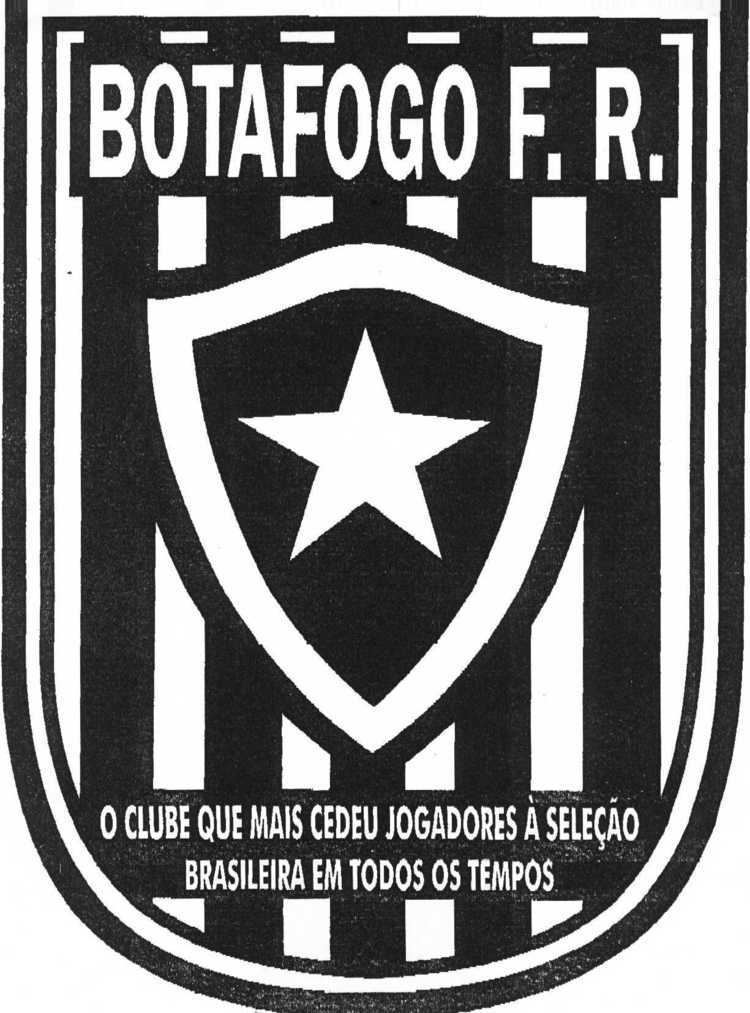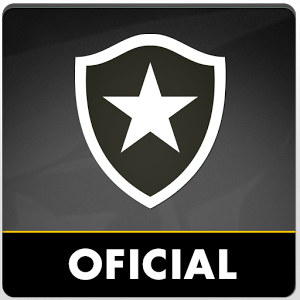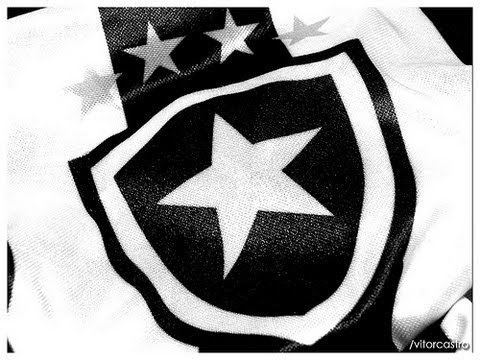Ground Capacity 46,831 Mascot Manequinho | President Carlos Eduardo Pereira Arena/Stadium Olympic Stadium Manager Jair Ventura | |
 | ||
Nickname(s) Fogão (The Great Fire)A Estrela Solitária (The Lone Star)O Glorioso (The Glorious One)O Mais Tradicional (The Most Traditional) 2016 Série A, 5th (classified to Libertadores) Profiles | ||
Botafogo de Futebol e Regatas ([bɔtaˈfoɡu dʒi futʃiˈbɔw i ʁeˈɡataʃ]; Botafogo Football and Regatta), also known as Botafogo and familiarly as A Estrela Solitária (The Lone Star), is a Brazilian sports club based in Botafogo, Rio de Janeiro. Although they compete in a number of different sports, Botafogo is mostly known for its association football team. It plays in the Campeonato Carioca, the state of Rio de Janeiro's premier state league and the Brasileirão Série A. It was appointed by FIFA to the group of the biggest clubs in the twentieth century.
Contents
- Formation and merger
- On the field
- Stadium
- Rivals
- Supporters
- Lone Star
- Flag
- Uniform
- Mascots
- Financial situation
- International
- Domestic
- Regional
- Current squad
- Out of team
- Out on loan
- Records
- References

In addition, the club has some of the top records of Brazilian football, as the largest number of unbeaten matches: 52 games between 1977 and 1978; the matches unbeaten record in the Brazilian Championship games: 42, also between 1977 and 1978; the largest number of players participations in total matches of the Brazil national football team (considering official and unofficial games): 1,094 participations and the largest number of players assigned to the Brazilian national team for World Cup. The club is still responsible for the greatest victory ever recorded in Brazilian football: 24-0 against Sport Club Mangueira in 1909.

Formation and merger
On July 1, 1894, Club de Regatas Botafogo was founded.

On August 12, 1904, another club was founded in the neighbourhood: the Electro Club, the name first given to the Botafogo Football Club. The idea came during an algebra lesson at Alfredo Gomes College, when Flávio Ramos wrote to his friend Emmanuel Sodré: "Itamar has a football club in Martins Ferreira Street. Let's establish another one, in Largo dos Leões, what do you think? We can speak to the Wernecks, to Arthur César, Vicente and Jacques". And so the Electro Club was founded. But this name wouldn't last. After a suggestion from Dona Chiquitota, Flávio's grandmother, the club finally became the Botafogo Football Club, on September 18 of the same year. The colours? Black and white., just like Juventus FC, the team of Itamar Tavares, one of the club's founders. And the badge, drawn by Basílio Vianna Jr., in Swiss style with the BFC monogram. The Botafogo Football Club would soon become one of the strongest football teams in Rio de Janeiro, winning the championships of 1907, 1910, 1912 and more.

The same name, the same location, the same colours and the most important thing: the same supporters. It seemed that the destiny of both clubs was to become one. And so it happened: on December 8, 1942 they finally merged. It was after a basketball match between both clubs, when Botafogo Football Club player Armando Albano died suddenly, that the idea began to become truth. At the tragic occasion, the president of Club de Regatas Botafogo, Augusto Frederico Schmidt (also a major Brazilian poet) spoke: "At this time, I declare to Albano that his last match ended with the victory of his team. We won't play no longer the time left on the clock. We all want the young fighter to leave this great night as a winner. This is how we salute him". Eduardo Góis Trindade, Botafogo Football Club's president said: "Between the matches of our clubs, only one can be the winner: Botafogo!". And then Schmidt declared the fusion: "What else do we need to our clubs become one?". And so they did: Botafogo de Futebol e Regatas finally became true. The Football Club's badge became black, and the monogram substituted by Clube de Regatas' lone star.
On the field

The team won the Campeonato Carioca in 1907, 1910 and 1912. In 1909 the team beat Mangueira 24–0, which remains the highest score in Brazilian football. They won further state titles in 1930, 1932, 1933, 1934 and 1935.

In the 1940s, after the creation of "Botafogo de Futebol e Regatas", the best player of the team was Heleno de Freitas. However, Heleno did not win a championship for Botafogo. He scored 204 goals in 233 matches but went to Boca Juniors in 1948, the year Botafogo won its 9th state championship.
They won the Campeonato Carioca in 1957, 1961 and 1962, and in 1968 they won Serie A, becoming the first carioca club to win the Brazilian league.
1989 ended a period of 21 years without a title when the club won the state championship, retaining the trophy in 1990.
In the 1990s, Botafogo won Copa Conmebol (the precursor of the current Copa Sudamericana). And in 1995 they won the Brazilian League for the second time in club's history, after drawing 1–1 the second leg of the Final against Santos FC at São Paulo.
Botafogo would be relegated to the Second Division after ranking last in the Brazilian League of 2002. In 2003, Botafogo ranked second in Brazil's Second division (after Palmeiras) and returned to the First Division.
In 2006, the club won for the 18th time the Rio de Janeiro State Championship. An them in 2010 and 2013 with the iconics Loco Abreu and Seedorf, respectively.
Nowadays, Botafogo is the only club to win titles in three different centuries, including the state championship of rowing in 1899.
Stadium
Their home ground is the Estádio Olímpico Nilton Santos, which name is in honour to former club player and two time world champion with Brazil National Football Team, the greatest left back of all time, Nilton Santos .
Other stadiums used by the club during its history are:
Rivals
Its biggest rivals are from the same city: Fluminense, Flamengo and Vasco da Gama.
The derby with Fluminense is known as the "Clássico Vovô" (Grandfather Derby) because is the odelst derby in the whole country. Both teams faced each other for the first time in 1905.
The match with Vasco is known as the Friendship Derby due to the supporters of both club been historically friends. IT´s the only "non violence" derby of the city.
The derby against Flamengo (The Rilvary Derby) is the biggest one for the club and onde of the more importants of the country. The clubs hate each other and the rivalry goes from the players on the pitch, the fans, to both club's boardroom. It´s probably the biggest rivalry in the city nowadays. Players that stand on these matches usually become idols of the club. Such examples are: Garrincha, Manga, Jairzinho, Túlio Maravilha and more recently Loco Abreu. Manga also is noted for a remarkable quote about this derby when He used to say that the player's prize money was already guaranteed because it was easy to beat Flamengo. The rival's biggest star Zico once said that at his childhood, Botafogo was the club he hated more because the Glorioso used to win all the derbies.
From outside the city, the club has a historically rivalry with Santos FC since the '60s and with Atlético Mineiro.
Supporters
Botafogo has one of the biggest supporters base in Brazil, been at the top 10 of the country's biggest fanbases. However, most of the club's supporters are located outside from the city of Rio de Janeiro, having numerous fans in all parts of the country, specially at the country side of the state of Minas Gerais and at the Northeast region of Brazil. Besides that, the club curiously has one of the biggest supporters bases of Brazilian's capital city Brasília.
Botafogo fans are known for their passion and loyalty, been alongside the team even in the bad moments like the two recently season at Série B. At the 2014 and 2017 editions of the Copa Libertadores the fans displayed a series of amazing presentations during the matches that called attention from the whole continnt, generating comparisons from the press with the Borussia Dortmund's Yellow Wall.
Lone Star
The Lone Star (Estrela Solitária) is currently present in Botafogo's flag and crest. This star was the principal symbol of Club de Regatas Botafogo. After the two Botafogos merged, the Lone Star became one of the most important symbols of Botafogo's football team.
Flag
The old flag of Club de Regatas Botafogo was white with a small black square which contained the Lone Star. The Football Club had a flag with nine black and white stripes with the club's crest localized in the center. Botafogo de Futebol e Regatas then based its flag on the two old clubs. The flag has five black and four white stripes, with a black square at the upper left side with the Lone Star.
Uniform
Their primary uniform consists of a black jersey with vertical white stripes, black shorts and grey socks. Their secondary uniform is all white. An all black uniform may also be used. The socks, although traditionally grey, may also be black or even white on rare occasions.
Mascots
In 1948 a stray dog named Biriba, known for urinating on the players, was the mascot that led them to the Campeonato Carioca. For some time before the adoption of Manequinho as mascot, Botafogo had Donald Duck as their mascot, associated with the team fans' fiery temper (as well as, notoriously, 1940s idol Heleno de Freitas). Due to image rights problems with the Walt Disney Company, Donald did not become an official mascot.
Financial situation
In 2006 Botafogo had Supergasbras and Alê as sponsors, the arrangement during that year earned the team $3.2 million (R$7.2 million). The next year, Botafogo managed to sign the sixth highest sponsorship deal in Brazil the new sponsor Liquigás, a Petrobrás subsidiary paid the club $3.9 million (R$7.8 million) under the terms of the 1-year contract. In 2008 not only the agreement with Liquigás was renewed for another year but it also became more lucrative since the sponsorship was raised to around $5 million (R$10.2 million).
Botafogo generated in 2007 the 12th biggest revenue for all Brazilian Football clubs, that year's revenues totalled $20.8 million (or R$41.1 million) but Botafogo had a net loss of $1.9 million (or R$3.7 million). Also at the end of 2007 Botafogo had total debts of $106.1 million (or R$209.7 million).
International
Domestic
Regional
(*)The only to win four times in a row
Current squad
As of 3 January 2017Note: Flags indicate national team as defined under FIFA eligibility rules. Players may hold more than one non-FIFA nationality.
Out of team
Note: Flags indicate national team as defined under FIFA eligibility rules. Players may hold more than one non-FIFA nationality.
Out on loan
Note: Flags indicate national team as defined under FIFA eligibility rules. Players may hold more than one non-FIFA nationality.
Records
Golden Ball winners:
